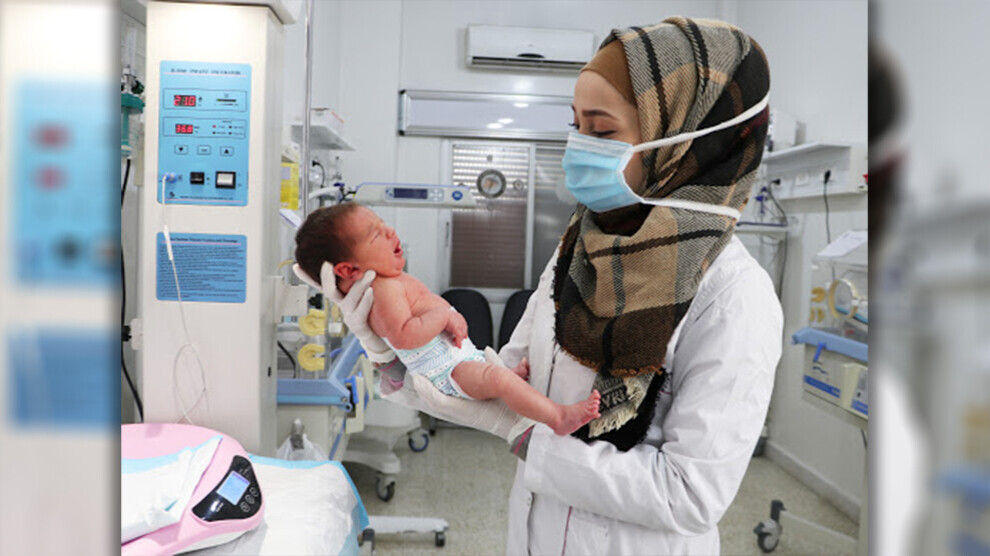Stillbirth rate rises in refugee camps of Idlib
IUFD (Intrauterine Fetal Death) has been increasing in northern Syria's refugee camps due to many reasons, including poor living conditions and a lack of health care services.

SUHAİR AL-IDLİBİ
Idlib – Pregnant women living in refugee camps located in northern Syria face difficult conditions due to poor living conditions and a lack of health care centers and these cause a recent spike in newborns death rate.
“There is no health center in the camp”
Hayat Al-Abbas, 35, said with a tear in her eye that she lost her fetus only two days before birth. After the fetus was tied by the umbilical cord surrounding it and prevented the delivery of nutrition to the fetus, which led to the death of the fetus, as explained to her by the midwife who assisted her in giving birth in her tent. “There is no health center that takes care of pregnant women's health and monitors their pregnancy in the Qah camp, where I stay with my family after our displacement. I could not go to hospitals and clinics because they are far from the camp,” she told NuJINHA.
She also told us that she would not risk getting pregnant again in such harsh conditions, fearing that she might lose her baby again.
Amal Abido (27) experienced the same story, she lost her unborn baby in her eighth month of pregnancy because she had severe anemia. She was about to lose life for the same reason due to lack of nutrition in addition to the difficult situation in the Atma camp where there is nothing but poverty and misery.
She could not afford to go to a gynecologist
Amal explained that she could not go to a gynecologist because she could not afford it. “The clinics are very far away from the camp,” she said that her husband is unemployed and they could not pay the costs of medications, lab analysis and other things that might be impossible.
Roa’ Hdid (30) could deliver her baby safely but the baby should have been held in an incubator device for several health reasons. However, the general governmental hospital in the region claimed all devices were full and there was no additional incubator for Hadid’s newborn who was left to die eventually.
“We couldn’t save my baby because we couldn’t afford the private hospitals that charge patients a lot, only wealthy people can afford those hospitals, that is why we lost our baby just hours after delivery” Roa’ said.
“The officials should take more responsibility”
45-year-old gynecologist Raydah Osman explained that the increasing number of fetus’ and newborn’s deaths is because of the huge shortage of pregnant women’s needs, especially getting enough nutrition and supplements.
She said that a pregnant woman could face many health problems that affect her and the fetus’ well-being. For example, her blood pressure, diabetes levels, anemia and calcium levels should be checked. There also might be types of specific infections associated with pregnancy which have to be treated. In general, a periodic examination is required to ensure the safety of the baby.
Doctor Osman called on the officials in the region to take more responsibility in the health sector and initiate more medical projects, especially in remote places and inside camps, “They should help pregnant women and their babies more both before and after the birth,” she said.
In the absence of official statistics on the number of fetus’ and newborns’ deaths, the Food and Agriculture Organization of the United Nations (FAO) and the Food Security Group said in a report on the humanitarian situation that:
42.3% of families have at least one pregnant woman and breastfeeding mothers.
16.6% of families have kids who are less than six months old.
30.1% of families have kids who are between six and 23 months.
On January 5, WHO issued an “emergency appeal” to provide 257.6 million dollars to secure health needs in Syria, maintain basic health care, including responding to the coronavirus pandemic, provide life-saving services and build a flexible health system.
The organization pointed out that in 2022:
12.2 million people would need health assistance, including four million displaced people, 1.33 million children under the age of five, and 3.38 million potential childbearing women.
